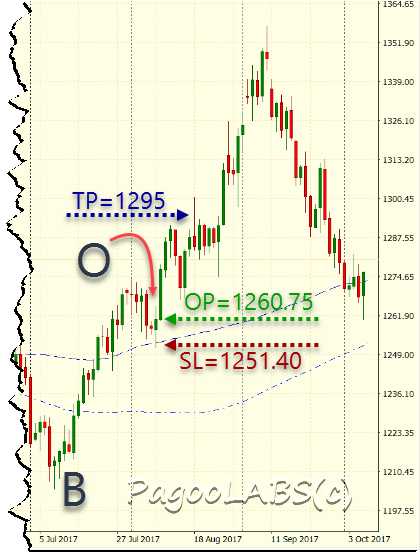Part 5 - The Conclusion of The Basic Setup
Margin
Before concluding our discussion of the basic trade setup I need to say a few words about margin. The stop loss being triggered is not the only reason your broker may close out your position. You will also be closed out if the remaining funds in your account, less the marked to market losses from a losing position, fall below a given amount. This amount is called the maintenance margin and it varies by contract as well as changing over time.
Each day your broker will mark-to-market your open positions. It is as if you closed the position, recognized any gains or losses at the day's closing price, and then immediately reopened a fresh position at the same price without paying commissions. Those gains and losses accumulate in your account and, if negative, your account will fall in value. Each open contract has a maintenance margin requirement and you must keep at least that amount of funds in your account.
The exchanges and regulatory authorities set the minimum margin but your broker may set a higher percentage to protect itself and its other clients from losses arising from your account. It is your job to familiarize yourself with the initial and maintenance margins of all the instruments you trade.
At the current price of gold at around $1280/oz, a contract of 100 ozs would cost $128,000 if you paid the full price. However the current initial margin requirement per contract is only $4,300, or just under 3.5%. That means you need $4,300 in your account for every gold contract you open. The maintenance margin, which applies after you have opened the position, is around $3250 or 2.5%. Your broker may set a higher amount. If you only had two open contracts then you would not fall afoul of the margin requirement since you would have $98K still in your account even at the SL price. That's more than enough to cover the $6,500 maintenance margin (2 x $3250).
However if you opened 20 contracts and your risk was $2000 per contract then at the SL price you would be losing $40,000 from your account leaving only $60,000. Since that is not enough to cover the $65,000 maintenance margin ($3,250 x 20 contracts) you would have already received a margin call from your broker. In many cases, they would automatically close the position in order to protect their firm and customers from losses occurring in your account.
It is important to recognize that your broker does not take into account your stop loss since the market may blow straight through it without pause. While you might think in terms of your risk being capped by the stop loss, your broker will instead be watching your available funds and the current value of your equity in the open position. This is more likely to cause a problem if the original dollar risk was small and you opened a large number of contracts.
The dollar risk gets smaller as you trade shorter timeframes. A typical setup on a 15 minute chart will almost certainly result in many more contracts than a setup from the daily chart. Those extra contracts may increase the risk of a margin call if there is a strong adverse price movement.
Another issue to be aware of is that if you trade frequently, the funds from your last trade may not yet have been settled. Although your account balance looks healthy, the funds from your previous trade are not yet available to cover the margin of a new position and the remaining available funds may not be enough to ward off a margin call.
Keep a watchful eye on margin and avoid opening any position where your available funds only barely cover the initial margin. Your broker probably has tools to help you calculate initial margin so stay alert to ensuring a margin call will never trigger before your stop loss.
Managing the Trade
 After all our hard work in coming this far, how did the trade work out?
After all our hard work in coming this far, how did the trade work out?
The trade was a winner! To the right you can see that the market blew straight up through our TP level and continued rising for quite some time before running out of steam. That's why we have TP levels. We don't know where the top of the market might be.
This trade was very profitable and the following table lays out the arithmetic that you can apply to any setup.
Profit in the Sample Gold Trade
Maximum Risk:
TF = $100,000 Total Funds (fixed)
MR = TF x 2% Maximum Risk
= $100,000 X 2%
= $2,000 Maximum Risk
Setup:
TP = 1295.00 Target Price
OP = 1260.75 Open Price (fixed)
SL = 1251.40 Stop Loss
CS = 100 Contract Size (fixed)
Trade Risk:
TR = OP - SL Trade Risk
Contract Risk:
CR = (OP - SL) x CS Contract Risk
= (1260.75 - 1251.40) x 100
= $935
Contract Potential Win (CW):
CW = (TP - OP) x CS Contract Win
= (1295.00 - 1260.75) x 100
= 34.25 x 100
= $3,425
Number of Contracts to Open = Max Risk / Contract Risk
CO = MR / CR Contracts to open
= $2000 / $935 Max Risk / Contract Risk
= 2.14
= 2 Contracts rounded down
Total Trade Risk:
TR = ContractRisk x Contracts=Total Risk of the trade
TR = CR * CO
= $935 x 2
= $1870
Total Potential Trade Win:
TW = CW x CO Total Potential Trade Win
= Win per Contract x Number of Contracts
= $3,425 x 2
= $6,850
Risk/Reward (Win) Ratio:
RRR = $1870 : $6850
= 1 : $6850 / $1870
= 1 : 3.66 Risk Reward Ratio
RR = 3.66 Risk Reward Multiplier
The risk/reward multiplier (RR) of the trade was 3.66, meaning the potential win was 3.66 times the size of the risk. That's considerably better than the double I hinted at earlier in this series. Most important, we knew the risk and the potential win before we entered the trade. We are $6,850 richer for each $100,000 of available funds, ignoring minor carrying costs for the eight days until the target was reached. We achieved that win without risking more than 2% of the funds we allocated toward futures and forex trading. When you manage your setups and position sizing as I outlined above, futures and forex markets can be no more risky than the way many investors trade equity markets.
Since the market continued to climb in a favorable direction, I appear to have left a lot on the table in this trade. You might have better ideas where to exit or you might observe another entry possibility following almost immediately, but that is not the purpose of this series of stories on basic setups.
Summary
This series of stories on the basic setup has covered a lot of territory and I will have more to say in future articles on many of the sub-topics mentioned above. For now you should have a good understanding of how to open a position and limit your risk while setting a target price compatible with your overall risk/reward ratio. You have learned:
- How to limit the size of your trades to 2% of your risk funds or less.
- How to only choose trades that have target prices that will result in wins greater than losses.
- How to calculate the number of contracts you can open without risking more than 2%.
- How to pay attention to your margin levels.
- How to define a trade setup.
What I have not yet described how to do in these stories is:
- calculate the TP
- identify a proper trade signal
- build a system out of individual signals
- lay out a setup in a forex instrument.
I will be writing about these topics in the coming weeks, so stay tuned.
Traders cannot guess the future. All we can hope for is to make sensible judgements about the trend and where support and resistance lie. Once we are comfortable with these important details, the next step is to adopt a strategy or system that is more likely to win over time. The following stories will lay out some of the elements of such a system.
Copyright (C) PagooLABS 2017. All Rights Reserved.

